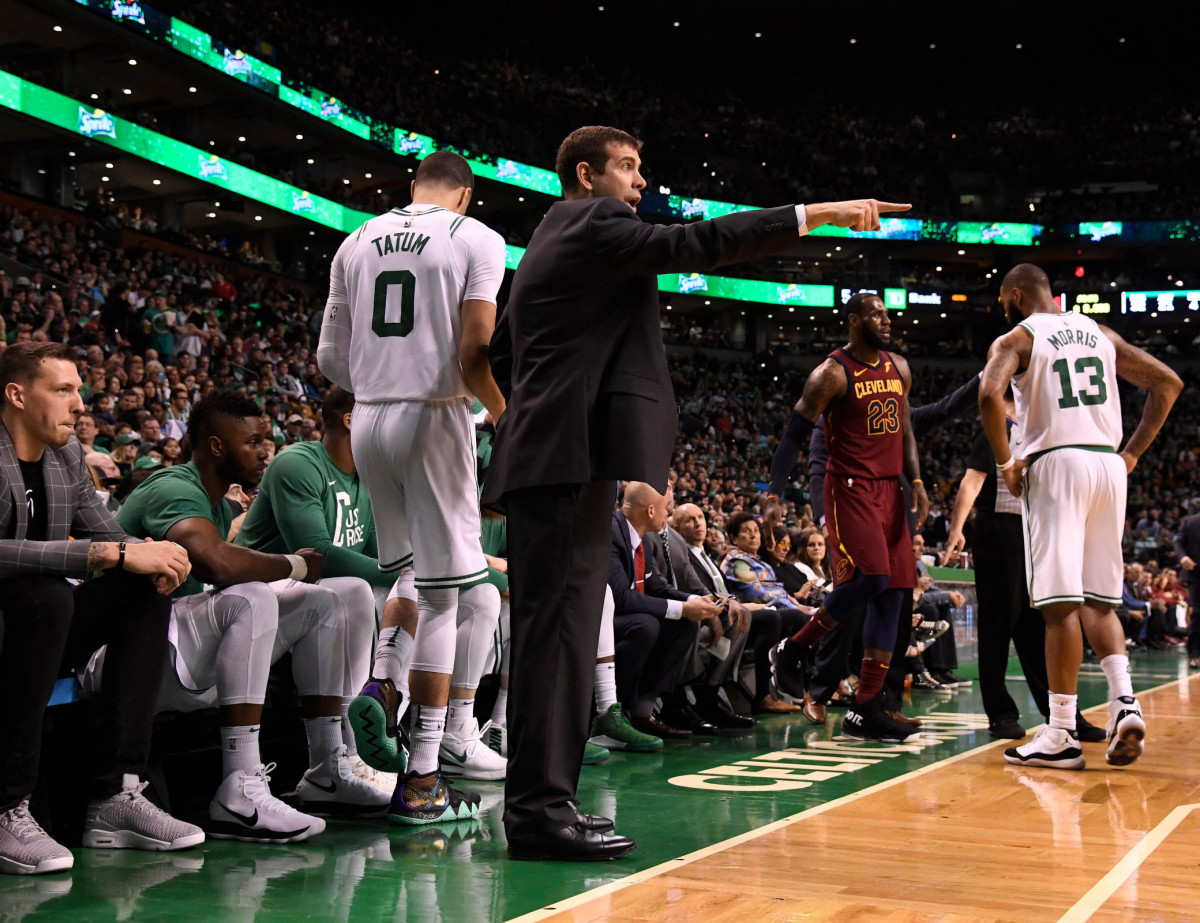No Underdogs Here: Boston Is on the Brink of NBA Finals for a Reason

The day before the start of the conference finals, Celtics point guard Marcus Smart was downplaying his team’s chances in its rematch with the Cavaliers. “The underdog is us,” said Smart, whose team had the second-best record in the East and homecourt advantage in the series. It’s a card the 24-year-old planned to use to his advantage. “The one thing about underdogs,” Smart continued, “is you have to fear them, because they have nothing to lose and everything to gain. This is a David-and-Goliath matchup.”
Twenty-four hours later it was less clear who was David and who was Goliath. Boston drubbed the Cavs 108–83, as Brad Stevens, who didn’t receive a sing Coach of the Year vote from his peers, found a way to slow down LeBron James, something that Toronto’s Dwane Casey—who was fired last week despite winning the award—could not do. In the past two postseasons James has scored fewer than 22 points in a game twice. Both times Stevens was the architect of his demise. In Game 1, James had 15 points on 16 shots, as Boston employed switch after switch to hound him into seven turnovers. Stevens made the decision to stick with Marcus Morris, who had touted his skills as a LeBron stopper, on James after the feisty power forward picked up two fouls in the first three minutes. Not pulling Morris was another example of the coach’s penchant for pulling all the right strings from the sideline, a trend that is coming to define Boston’s improbable postseason.
The Celtics Are Built to Harass LeBron James
Stevens’s signature call came in Game 3 of the second round, against the 76ers. Boston was trailing 98–97 with 8.4 seconds remaining in overtime. Stevens had already drawn up a play that led to a game-tying Jaylen Brown layup in the final minute of regulation. Now, with Philly on the verge of closing within 2–1 and regaining momentum in the series, Stevens was in the huddle, clipboard in hand, coolly doing what he does best. “He’s the after-timeout czar,” says Boston guard Shane Larkin.
Stevens knew exactly how he wanted to attack. He drew up a series of screens on the near block designed to isolate center Al Horford on Philly small forward Robert Covington, action that momentarily left some of his players a bit perplexed. “On the bench you’re kind of watching like, O.K. that’s the first move, O.K. that’s the second move, now there’s the third move,” Larkin says. “And then—oh, he’s open.”
After the flurry of screens, Horford got Covington one-on-one, held him off, received a perfect lob from Morris and laid in the go-ahead basket. Boston won the series in five games. “It just blows my mind how [Stevens] knows what’s going to be open,” rookie Jayson Tatum says. “I swear, like 95% of the time it works.”
The Celtics are right where everyone expected them to be at the start of the season but few predicted at the start of the playoffs. Both of the team’s marquee offseason pickups, forward Gordon Hayward and guard Kyrie Irving, went down with season-ending injuries, Hayward on opening night and Irving in March. Faced with a situation that couldn’t be fixed with one timely play call, Stevens relied on another skill.

Hearing the Celtics—or, for that matter, their fans—talk about Stevens is not unlike listening to cultists discussing their leader. (The coach is quick to deflect. “It’s silly,” he said the day after Game 1. “The praise is uncomfortable. . . . These guys should be getting it all. We all have a role to play. And we all need to play that role as well as we can.”) The Celtics express awe at Stevens’s ability to exploit weaknesses when drawing up plays, but they’re more moved by his demeanor. Sure, the Hoosier has a fierceness that belies his dad-next-door appearance, but his team responds best to his quiet confidence. Says Larkin, “Even when we’re down 22 points [as the Celtics were in a Game 2 win over the Sixers], he’ll tell us we’re doing good things, or getting great shots. If your coach is confident and calm while all of this is going on, you take that and rock with it.”
So when Irving was lost for the playoffs, there was no special address. There was no win-one-for–Uncle Drew speech. “He just called on the next guy,” Smart says. “He told him to go to work. It was a little more responsibility for everybody, and everybody stepped up.”
You Don’t Have to Forgive Kevin Durant, but You Do Have to Appreciate Him
Irving is still around, sitting on the bench during home games, and he’s active in the team’s group chat, encouraging those in his place to play as they always have and to take advantage of their opportunities. And they have. This is a team that—thanks to president Danny Ainge’s insistence on amassing and protecting draft picks, to the point that he became a punch line—is stacked with lottery selections. Tatum and Brown were the No. 3 picks in the past two drafts, Smart went sixth in 2014 and Rozier was a mid-first-rounder in ’15. Scary Terry, who has slotted into Irving’s starting role, has made the most of his minutes. The swaggering, three-point bombing, Drew Bledsoe-appreciating folk hero is equally adept at pulling up for a long-distance heave and putting a forearm into a 7-footer’s chest on a drive to the hole. In the postseason he’s raised his scoring average from 11.3 points per game to 17.4 while shooting nearly 40% from three.
But Irving’s absence didn’t just open up playing time; it also created a void where the offense’s No. 1 option had been. And in stepped Tatum. The rookie mixes a quiet confidence with an absurdly polished game for a 20-year-old. He’s effective in transition. He can knock down catch-and-shoots. He can pull up coming off a screen. And if the Celtics are desperate for a bucket, the 6'8" 205-pounder can post up a smaller player and find a good look.

Tatum thoroughly outplayed Ben Simmons—the Rookie of the Year favorite—in the second round. He averaged 23.6 points, with a 62.6% true-shooting percentage. Against the Cavs he had 16 on just 11 shots in Game 1. Tatum’s evolution has become more pronounced since Irving was sidelined. Early in the year Tatum was most known as an outside shooter; now he’s a consistent bucket-getter who can carry an offense. His usage rate has increased from 19.6 in the regular season to 24.3 in the playoffs. He’s still shooting plenty of three-pointers (3.8 per game), but significantly fewer are catch-and-shoot. In the regular season 44.6% of Tatum’s attempts came after he’d held the ball for less than two seconds. In the playoffs that number has decreased to 30.6%. He’s also getting to the rim more often. In the postseason 38.8% of his shots have come from inside three feet, up from 32.0% in the regular season.
“I always had that confidence from the beginning of the season,” Tatum says. The rookie never had an explicit conversation with Stevens about expanding his role after Hayward, and then Irving, went down. “It was all about getting comfortable, getting experience and getting the opportunity.”
Before a recent game Larkin, himself only 25, mentioned Tatum’s youth. Tatum, at the locker next to his, overheard the comment. “Why I gotta be young, Shane?” Tatum joked. “How much longer will you be saying that?” Boston’s opponents are already wise to how misleading age can be. After his team was eliminated by the Celtics, Philly coach Brett Brown said, “If we’re going to do anything of any significance, we’re always going to have to go through the Boston Celtics.” This, even with LeBron James and his seven straight Finals appearances potentially hanging around. Of course, James could still easily make that eight in a row; he’s been blown out of playoff games before, including an 18-point loss to the Pacers in Game 1 of the first round. But one thing is certain: Injuries or not, the Celtics aren’t going to be underdogs much longer.
